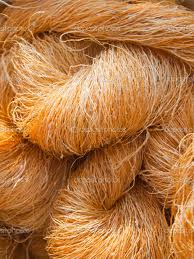Modelling the effect of temperature on specific death rate of the micro-flora of raw cotton wool
Keywords:
Cotton wool, Bacterial, Death rate, Sterilization, Temperature, ArrheniusAbstract
Cotton wool for use in medicine must be sterilized and heat treatment is the most common sterilization technique for bulk processing of agricultural materials. Modelling the effect of temperature variations on specific death rate of the micro-flora of raw cotton wool was carried out in this project. The raw cotton wool was collected from a farmer in Kano State, the most important cotton wool producing state of Nigeria. The micro-flora was determined by inoculating and incubating with 0.85% NaCl diluents and the number of bacteria determined by plate count method. As the sterilization temperatures were varied with increased time, the thermal death rates and thermal death time of the micro-flora were determined for each temperature and these was used in the modelling. The model lnK = 83.9 – 34190(1/T) shows that the sterilization temperature has a linear relationship with the death rate constant and it is in line with Arrhenius model.
References
Mulcock, A.P., Horn, P.E., 1965. Thermophilic bacteria from wool, New Zealand Journal of Agricultural Research, 8,4, 818-824
Casolari, A., 1994. About Basic Parameters of Food Sterilization technology. Food Microbiology II. 75-84
Humfield, H., Elmquist, R.E., Ketiering, J. H., 1937. The sterilization of wool and its effect on physical and chemical properties of a wool fabric. U.S. Dep. Agric. Technol. Bull. 588. 27 pp.
Ibe, S.N., Aminigo, E.R., Aniebo, C.M., 2007. Introductory Microbiology University of Port Harcourt Press pg 28.
Karmakar, S.R., 1999. Chemical Technology in the pre-treament processes of textiles, Elsevier science B.v 34
Kenneth, T., 2009. The Control of Microdial Growth. University of Wisconsinmadison, Department of Bacteriology.
Mcquade, A.B., 1964. Microbiological degradation of wool. Dermatologica 128: 249-66.
Menier, J., 1988. "Sur quelques insectes deprédateur des archives," Patrimoine culturel et alterations biologiques. Actes des journees d’etudes de la S.F.I.I.C., Poitiers, 17-18November45-52.
Opara. C.C., 2002. Biochemical and Microbiological Engineering. Chijioke Consultants. ISBN 98732829-6, pg261 – 265.
Rollins, M.L., 1965. The American cotton hand book, Dame S. Hamby, Ed., interscience publishers, New York.
Sridhar R.P.N., 2008. Sterilization and Disinfection. Department of microbiology JJMMC, Davangere.
Stahl, W.H., Mcque, B., Mandels, G.R., Sm, R.G.H., 1950. Studies on the microbiological degradation of wool. Digestion of normal and modified fibrillar proteins. Text. Res. I. 20: 570-9.
Tayme, G., Balser, K.L., 1970. Melliand Text,51.
Truter, V., 1952. Wool wax Chemistry and Technology. Ist ed. Pp. 31 – 72. Cleaver- Hume press, London. 386 pp.
Willey, J.M., Sherwood, L.M., Woolverton, C.J., 2008. Prescolt,Harley and Klein’s Microbiology. Mc Graw Hill.
Noval, J.J., Nickerson, W.J., 1959. Decomposition Of Native Keratin By Streptomyces fradiae. I. Bact. 77: 251-63.
Yashmin, S., 2007. Sterilization methods and principles. Hamdard Nagar New Delhi.

Published
How to Cite
Issue
Section
Copyright (c) 2013 C. C. Opara, U. I. Osuagwu, M. M. Atuka

This work is licensed under a Creative Commons Attribution-NonCommercial-NoDerivatives 4.0 International License.
